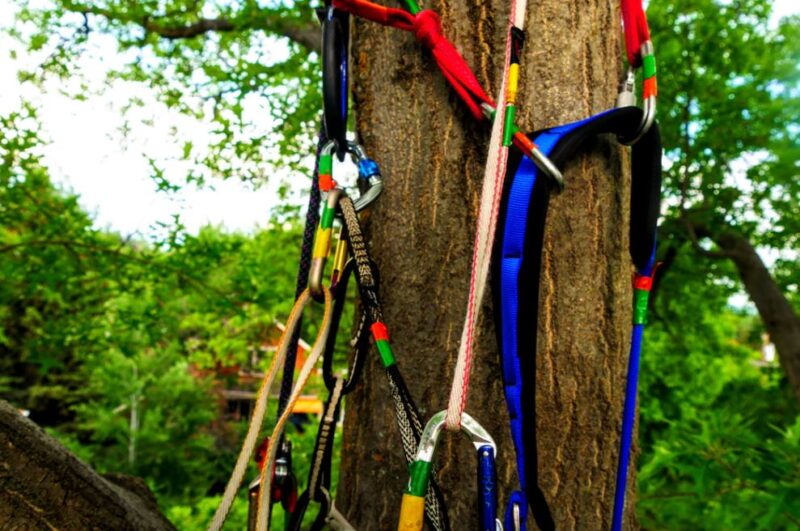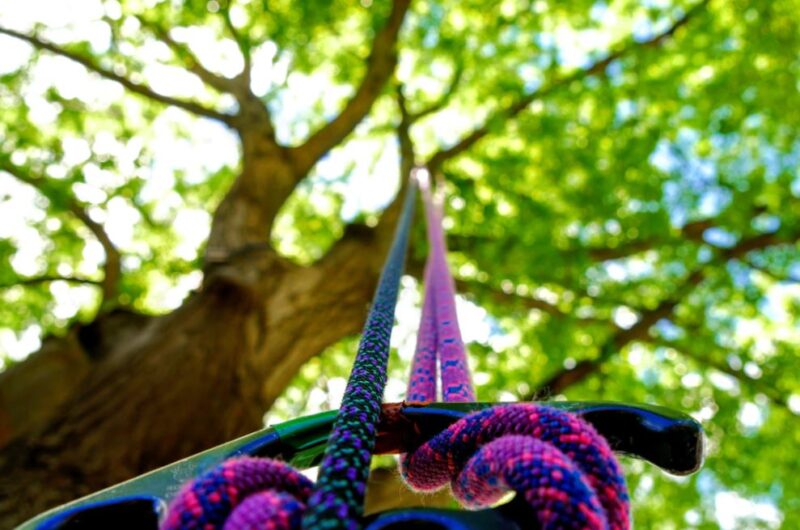Tree climbing is one of the most exciting activities that you can try if you are into climbing and nature like us. It’s a great way to get out and enjoy nature while getting some exercise at the same time. However, it isn’t as simple as just throwing on your old sneakers and taking off into a tree-lined forest somewhere. There are actually several important and safety focused things that need to be considered before you start climbing trees on your own or with a guide.

What is tree climbing
Tree climbing refers to the activity of ascending a tall natural structure, such as a tree. Climbers utilize ropes and harnesses which are attached firmly to the trunk or branches in order to provide stability from falling mid-climb. Ropes can be used either singularly or combined with additional lines for an added level of safety.
How do you get started as a beginner
The first thing that you need before getting into any form of tree climbing is obviously going to have some sort of gear available and try it with a qualified tree climbing instructor. This includes things like ropes, belts, slings, gloves and other protective equipment depending on your preferred method of ascent (more on this later).

In terms of where you’re actually going to climb, this is something of a personal preference. Most tree climbers tend to stick to forests or wooded areas because the trees there are far sturdier and less likely to snap from being climbed on. You can, however, climb just about anywhere as long as you have easy access both up and down once you’ve reached your desired height. However, a word of precaution that this sport can be a dangerous sport hence it is advised to do it with someone experienced and qualified.
What should you wear for tree climbing
Tree climbers need a special type of shoe that can be worn both on the ground and when they are in the trees. The right shoes will have treads so that your feet don’t slip while you’re walking up trunks or over branches; they should also have a good grip since you’re going to be climbing all over the tree. The shoe should also provide ankle support as well, which is especially important if an accident occurs and someone falls out of the tree or down toward the ground.
What tree climbing gear and equipment is needed for safety
It’s important to have the right tools and gear for tree climbing. You’ll need a tree climbing harness and carabiner, slings, rope or line of some kind, gloves, chaps (optional), and a helmet with face protection. A few other protection and precautionary survival items can also be useful to take along on your adventures if you’re going somewhere where there are poisonous plants or animals that might harm you.
1. Tree Climbing Safety Harness
A tree climbing safety harness is what you’ll need to secure yourself when you’re in the trees. It has two leg loops that go around your legs and one strap across your chest for added stability. The seat part of the tree climbing harness should be worn low on your hips, not up by your waist or ribs; this position will keep you from slipping right out of your harness if you’re hanging upside down at any point. If you need recommendations on the best tree climbing harness, we have a compiled list here.
2. Tree Climbing Rope
The right kind of rope is also very important to have when you’re climbing trees. A dynamic line can help prevent injuries if someone falls, but it’s not always necessary for beginners or younger climbers who are just learning how to get around without hurting themselves. Many people choose a static cord that has little stretch in it so they feel more secure while they’re climbing, but they have to be very careful not to put too much strain on the rope when they are ascending or descending so it doesn’t snap.
3. Tree Climbing Gloves
You’ll need gloves with a good grip in order to keep from slipping while you climb around in trees and over branches. Climbing chaps can also come in handy if there are any poison ivy plants or anything else that can cause a rash around where you’ll be climbing.
4. Helmet with face protection
A helmet with face protection is also very important because it will protect your head from falling objects and branches as well as keep you safe if there’s ever an accident involving someone falling out of the tree toward the ground.
5. Tree Climbing Clothing
There are some other items that can come in very handy, especially if you’re going to be doing any kind of climbing outside. Long pants will protect your legs from scrapes and cuts as well as insect bites, so it’s not a bad idea to wear them even when the weather is hot during certain parts of the year. A shirt with long sleeves and a high collar is another great idea for extra protection while you’re climbing; it can also keep you from getting sunburned more easily if the weather isn’t too hot outside.
Don’t wear sandals, flip-flops or shoes with open toes when climbing trees; this will help keep your feet safe from any cuts that might come along while you’re walking around on branches and trunks.
Useful Tree Climbing Tips For Beginners
There are some tree climbing tips that beginners should take into consideration before they get started. These are some helpful guidelines to follow so you can avoid injuries and learn how to climb in the safest way possible.

- Don’t try to climb trees when you’re tired or hungry; these are conditions that can lead to accidents and injuries. It’s best to go out tree climbing early in the morning, late in the afternoon, or after a good night of sleep so you don’t have any distractions while you’re practicing your techniques.
- Start off climbing around on small trees that are closer to the ground; this will help you get used to wearing your gear and managing your balance while you’re climbing.
- Don’t go too high or try any advanced techniques until you’ve mastered what it takes to get up, down, and around safely! It’s better to climb lower than higher when you’re just starting out.
- Make sure that someone knows where you are before you even start climbing trees; this way they’ll know if anything goes wrong while you’re up there.
- Never try to climb out of a tree if it’s too dangerous, especially when someone is with you; this can be very risky and is not recommended unless your life depends on getting down from that particular spot quickly! It might be better to stay where you are until help comes along instead of trying something rash by yourself.
Different types of trees and their best uses
There are several different kinds of trees that make ideal climbing choices. If you’re going to be trying out your new skills in a forest or other wooded area for the very first time, it’s best to go with an evergreen tree. These are typically easier to climb, and they have branches that are more widely spaced apart which makes it much simpler for beginners to move around on them.

If you’re planning on doing some professional-level climbing or if you just want a challenge, then oak, elm or hickory trees are the kinds of trees to go with. These don’t have branches that come off as close together, which means you’re going to be working harder than normal when climbing these types of trunks.
Autumn is a great time for tree climbers because there are so many different things that can be done.

Important Tree-climbing safety tips
When it comes to tree climbing, the most important thing is safety first. Not only will a proper tree-climbing helmet protect your head and face from injury, but it can also make sure that you have the best view possible of your surroundings. It’s also important to be aware that you can climb trees in just about any weather, even if it is raining or snowing.
In Summary
- Wear the proper shoes
- Make sure you have all of the right equipment – harness and carabiner (rope or line), gloves , chaps (optional) and a helmet with face protection
- Always make sure someone knows where you are
- Don’t overdo it the first time and take things slow when climbing different branches
- Go with an evergreen tree if this is your first time doing any kind of professional tree climbing or just want a challenge, oak, elm or hickory trees for best results.

Always remember to be safe while trying new things. While there are many advantages of tree climbing from it being a great exercise activity, fun outdoor experiences that are very rewarding overall as you learn more about nature while getting some fresh air in your lungs at the same time! If this is something you’ve always wanted to try, I hope this guide of tips can help you kickstart your tree climbing journey.

No Comments